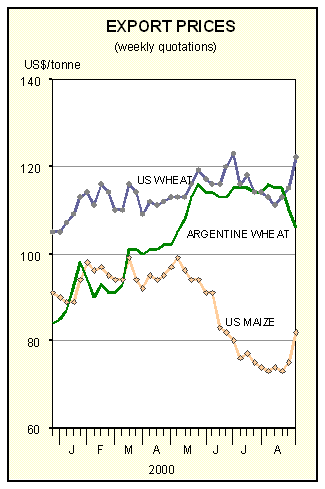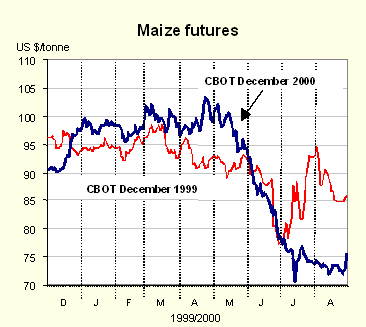


Overall, international cereal prices have remained under downward pressure since May despite prospects for much smaller world stocks forecast for this season. For wheat and coarse grains, the reason for the latest weakening of the international prices lies mostly on seasonal factors, i.e. the harvesting pressure. However, the more important reason for the continuing weak prices is also the existence of large inventories of wheat and coarse grains held by the major exporters and the likelihood that these inventories could rise even further by the end of the crop seasons in 2001. The bulk of world grain stocks has traditionally been held in only a few countries/regions: namely, the major grain exporters (Australia, Argentina, Canada, the EC and the United States) as well as a few others, including China and India. Generally, however, only Canada, the EC and the United States maintain any significant volume of grain stocks over and above working or pipeline levels (i.e. those required to assure an uninterrupted flow of supplies). Consequently, the market's expectation of large stocks in major exporting countries has continued to counter negative sentiment arising from large production shortfalls in a number of other important grain producing countries (such as China) and the subsequent decline in global stocks.

The drop in international prices of coarse grains has been most profound in recent months. In August, the US maize export prices averaged US$76 per tonne, US$19 per tonne lower than in May and US$16 per tonne, or 17 percent, below August 1999. Similarly, barley and sorghum export prices have also weakened substantially compared to the previous year. On the Chicago Board of Trade (CBOT) futures markets, the expected record maize crop in the United States and the increasingly likely prospects of higher United States' stocks kept maize prices under pressure. Over the past few months, the December 2000 maize futures continued to slide, although by late August it began to strengthen a bit and was quoted at US$76 per tonne, nevertheless still some US$9 per tonne down from the corresponding period last year. With the maize harvest approaching in the northern hemisphere, the downward pressure on prices is likely to continue for some time, barring any sudden or unexpected increase in world demand.
International wheat prices also eroded further during most of the period since the last report. In late August, however, reports of less favourable crop prospects in Canada and reluctance of the EC to sell new crop wheat, resulted in a sudden surge in prices. Overall, the US wheat No. 2 (HRW, fob) averaged US$115 per tonne in August, down US$1 per tonne from May but similar to that quoted in August 1999. In the futures market, the favourable supply outlook in major exporting countries continued to weigh on the CBOT soft red winter prices, despite prospects of increases in exports from the United States amid a likely cutback in EC sales. By late August, the December wheat contracts showed some recovery, again mostly in response to concerns about unfavourable production prospects in Canada, but, at US$99 per tonne, prices were still US$3 per tonne below the corresponding period in 1999. With harvesting nearly completed in the several important countries and the demand outlook relatively strong, wheat prices are likely to start rising. However, the upside may prove largely limited, particularly for low quality wheat, in view of this year's ample maize supplies and the already large (around US$20 per tonne) difference between the quoted wheat and maize prices in world markets.
| 2000 | 1999 | ||
| Aug. | May | Aug. | |
| (. . . . . US$/tonne . . . . .) | |||
| United States | |||
| Wheat 1/ | 115 | 116 | 115 |
| Maize | 76 | 95 | 92 |
| Sorghum | 76 | 95 | 94 |
| Argentina 2/ | |||
| Wheat | 111 | 112 | 129 |
| Maize | 74 | 87 | 97 |
| Thailand 2/ | |||
| Rice white 3/ | 189 | 210 | 249 |
| Rice, broken 4/ | 143 | 143 | 204 |
Source: FAO, see Appendix Table A.6* Prices refer to the monthly average.1/ No. 2 Hard Winter (Ordinary Protein).2/ Indicative traded prices.3/ 100% second grade, f.o.b. Bangkok.4/ A1 super, f.o.b. Bangkok.
The general weakness in international rice prices continued to manifest itself through August, reflecting the oversupply situation on the international market relative to import demand. The resulting downward pressure has pushed the FAO Export Price Index for Rice (1982-84=100) to its lowest level since September 1993. The index averaged 95 points in August, down by 1 point from May and by 21 points from August 1999. Additional downward pressure on rice prices emanates from the arrival of new crop supplies on the market in some countries amidst weak international import demand.


The price for the high quality Thai 100%B averaged US$189 per tonne in August, down by about US$21 per tonne from May and the lowest since February 1987. By comparison, the price was US$249 per tonne in August 1999. Prices of the lower quality grades from various origins also fell further in August. The price of Thai 35 percent brokens, which has been on a steady decline since the beginning of the year, averaged US$158 per tonne in August, down by US$5 per tonne from the May average and compared to US$215 per tonne in August 1999. However, over the same period, the price of fully broken rice (Thai A1 Super) was unchanged at US$143 per tonne, due to reduced milling activity, although it is down by US$61 per tonne from its August 1999 average.
In Viet Nam, prices of most grades received some upward support during July, as the market participants were getting increasingly concerned about the impact of floods on the supply. However, prices eased again in August as more rice is becoming available at a time when import demand is limited.
By contrast, there has been increased export-related activity over the last couple of months in the United States, much of which involved tenders and shipments under the food aid programs. The price of the United States No. 2/4 percent broken rice averaged US$260 per tonne in August, up by US$3 per tonne from May but down by US$62 per tonne from August 1999.
For the remainder of the year and assuming no supply and/or demand shock, international rice prices are expected to continue their downward trend.